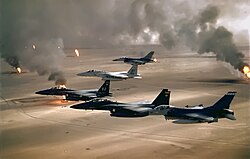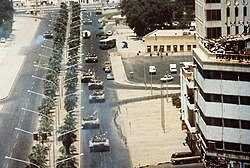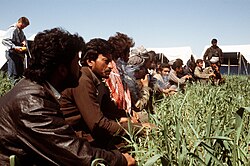
The Gulf War (1990–1991) or First Gulf War was a war fought between August 1990 and February 1991. It began when Iraq under the Ba’ath Party and the dictator, Saddam Hussein, invaded Kuwait, a small neighboring state on the Persian Gulf. Hussein hoped to annex Kuwait, which was oil rich and to which Iraq owed large sums of money after the Iran-Iraq War (1980–1988). The conquest of Kuwait drew a response from the United States and its allies. After a troop build-up in Saudi Arabia, they launched Operation Desert Storm in January 1991. This was a limited operation to liberate Kuwait. The US did not follow up with a full invasion of Iraq itself. Diplomatic and economic sanctions were imposed on Iraq in the aftermath of the war. It triggered a wave of refugee migration from Iraq to neighboring countries as the regime in Iraq was destabilized. The Gulf War and the Iraq War (2003–2011) were significant contributors to the emergence of an Iraqi diaspora around the world in modern times. The initial Iraqi invasion of Kuwait also led to a massive refugee flight from Kuwait.[1]
Research your ancestors on MyHeritage
Gulf War chronology of eventsGulf War chronology of events

The Ba’ath movement seized control of Iraq in 1968 after a decade of political instability in its politics. Saddam Hussein gradually rose to power within Ba’athist Iraq, becoming president of the country as de-facto dictator from 1979 onwards. A year later he initiated a war with neighboring Iran. The long-running Iran-Iraq War did not go as planned and after nearly a decade of bitter conflict ended in 1988 with nothing gained and enormous debts accumulated. Much of this debt was owed to Kuwait, Iraq’s southern neighbor in the Persian Gulf region. The country is small but is oil-rich and well enough managed that it had money to loan to the Iraqis. Once the war with Iran was over Saddam decided not only to renege on paying these debts back, but to invade Kuwait and take over the country. The invasion of Kuwait began on the 2nd of August 1990. The invasion met with little resistance and by the 4th of August the country was under Iraqi control and was soon annexed and reorganized into a province of Iraq.[2]

International opinion was outraged by Hussein’s actions. On the 5th of August 1990 US President George H. Bush gave a speech in which he indicated that a response would ensue from the United States. Operation Desert Shield followed. This involved a very substantial troop build-up in Saudi Arabia through the autumn and winter of 1990 by US troops, along with those of Britain, France and other allies. In November a resolution was issued by the United Nations demanding that Iraqi forces withdraw from Kuwait by the 15th of January 1991 or face military expulsion. Talks between the US-led alliance and the Iraqis continued into early 1991, ultimately to no avail.[3]
On the 17th of January 1991, two days after the expiration of the United Nations deadline, the US launched Operation Desert Storm. The campaign aimed to expel Iraq from the small Gulf state over the next several weeks. Operation Desert Storm lasted six weeks. Fighting spilled over into parts of southern Iraq and into Saudi Arabia, but was largely one-sided. Eventually a ground invasion of Kuwait followed after bombing missions and strategic targeting. The US and their allies did not initiate a major invasion of Iraq itself and chose not to engage in regime change. They did encourage a major uprising amongst the Kurdish minority in the north of Iraq who had suffered greatly under Ba’athist rule, particularly so in the 1980s. The Gulf War was largely over by the end of February 1991. Though the war was short, it resulted in around 140,000 deaths, most civilians.[4] Twelve years later President Bush’s son, George W. Bush, launched a fresh war against Iraq, this time dealing in regime change.[5]
Extent of migration during and after the Gulf WarExtent of migration during and after the Gulf War

The Gulf War led to several very large waves of migration from and to different places. In the initial phase of it the war led to the flight of approximately 400,000 Kuwaitis from their country to nearby countries in the Middle East like Saudi Arabia and Jordan.[6] Then, as the US and its allies began the bombing campaign against Iraq and the Iraqi state was destabilized, hundreds of thousands of people from within Iraq itself began fleeing to other countries in the region. This notably involved the large Kurdish minority in the north of Iraq. It is estimated that as many as one million Kurds sought to leave the country for Turkey and Iran after the failure of the Kurdish revolt, though huge numbers were prevented from doing so.[7]
Finally, after the war there were repercussions that led to yet another wave of migration. Hundreds of thousands of Palestinian refugees had made Kuwait their home since the middle of the twentieth century. Owing to the political ties between Yasser Arafat’s Palestine Liberation Organization (PLO) and Hussein’s Iraq, the Palestinian community in Kuwait faced reprisals from the Kuwaiti government in the spring of 1991 after the war ended. In the space of a few weeks in March 1991 roughly 300,000 ethnic Palestinians in Kuwait left or were forcibly deported. Many had Jordanian passports and ended up there.[8]
Demographic impact of the Gulf WarDemographic impact of the Gulf War
The demographic impact of the Gulf War was felt in very many countries. In Kuwait the initial demographic impact was huge. The population fell from 2.2 million people in 1989 to 1.3 in 1991. It only gradually recovered and would not return to its pre-war levels until the mid-2000s.[9] Conversely, the population of Jordan spiked upwards from 3.3 million people in 1989 to four million people in 1993. Many Kurds ended up leaving Iraq as a result of the war and there was further dislocation of other groups.[10]
See alsoSee also
Explore more about the Gulf WarExplore more about the Gulf War
- Human Rights Watch World Report 1990 – Iraq and Occupied Kuwait at Refworld
- Gulf War at the National Army Museum
- The 1991 Uprising in Iraq and its Aftermath at Human Rights Watch
References
- ↑ https://www.nam.ac.uk/explore/gulf-war
- ↑ https://adst.org/2016/09/sparking-iraqs-invasion-kuwait-loans-land-oil-access/
- ↑ https://www.britannica.com/list/persian-gulf-war-timeline
- ↑ https://www.britishlegion.org.uk/stories/the-gulf-war
- ↑ https://www.cfr.org/timeline/iraq-war
- ↑ https://www.refworld.org/reference/annualreport/hrw/1991/en/43631
- ↑ https://www.bbc.co.uk/news/in-pictures-35967389
- ↑ Yann Le Troquer and Rozenn Hommery al-Oudat, ‘From Kuwait to Jordan’, in Journal of Palestine Studies, Vol. 28, No. 3 (Spring, 1999), pp. 37–51.
- ↑ https://www.worldometers.info/world-population/kuwait-population/
- ↑ https://www.worldometers.info/world-population/jordan-population/

